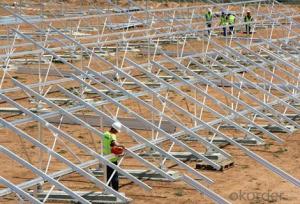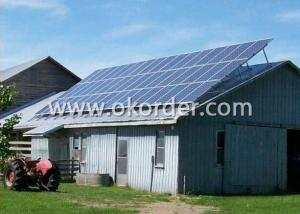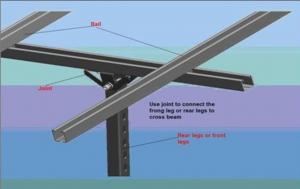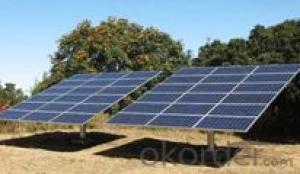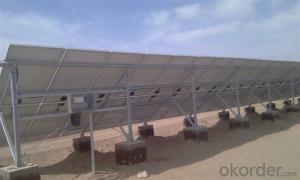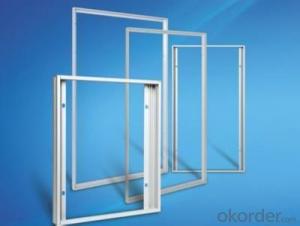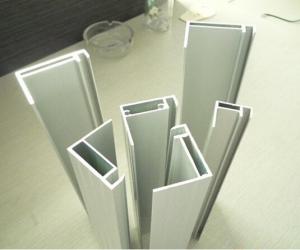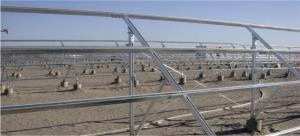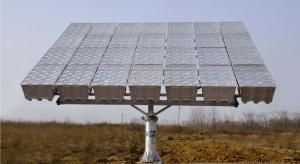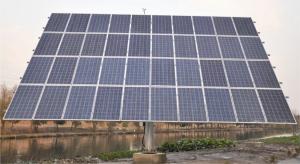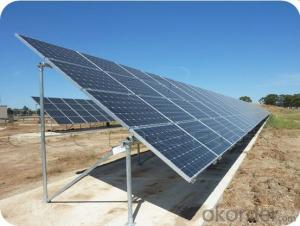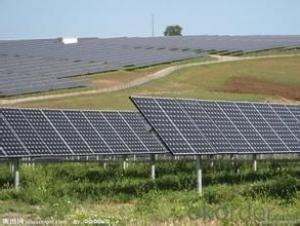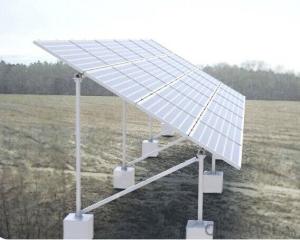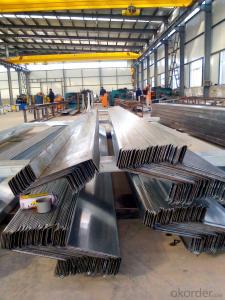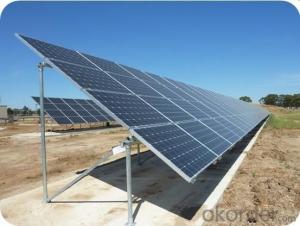Solar Panel Monting System TT-TK-S05
- Loading Port:
- Shanghai
- Payment Terms:
- TT OR LC
- Min Order Qty:
- -
- Supply Capability:
- 50万套 set/month
OKorder Service Pledge
OKorder Financial Service
You Might Also Like
PV Mounting brackets are special solar photovoltaic systemfor placing, installing, fixing the solar panel design. Generally materials arealuminum, steel structure, stainless steel. PV mounting products at groundmounting system, flat roof mounting system, adjustable angle roof rack system,inclined roof rack system, column bracket system.
The Ground Mounting System including concret basement sysytemand steel pipe sysytem, Titanergy provides total solution for flat or pitchedroof with patent products.On the basis of the given project data, specificnational standards and guidelines, Titanergy will calculate the completestructural analysis and create a complete project plan to make sure reliablestructural safety.We provide high quality HDG steel and aluminum products forthe ground mounting sysytem,witch can make sure the security and durability ofthe project.
Features and Advantages
n The rail bracket is easy to install, just use simple tools(eg, Allen wrench) can be easily installed. Rail connecting member can freelyadjust the length, the stent may be pre-installed on the roof, and thenappropriately adjusted according to the size of the solar panel.
n The combination of strong, aluminum rails and card blocks fora variety of venues and a variety of materials roofs (such as metal, ceramicand other kinds of tile surface)
n Component compatibility, and rail can meet PV modules fromdifferent manufacturers.
n accuracy, the length of the rail to the nearest millimeter,the construction process, not because of the length is too long or too shortfor the second cut.
n flexible assembly, rail hooks can adjust the spacing modulearray and tile has been installed successfully address the uneven roofconstruction led to difficult problems.
n design standards, product design and development process instrict accordance with GB, the German standards and other internationalstandards to ensure products reach the world advanced level.
n Quality assurance, the stent main material is high-qualityaluminum and stainless steel, effectively prevent corrosion of oxidation.Products can be recycled, reducing environmental pollution.
n Carried out strictly according to the current specificnational standards
n Perfectly optimized components and complete structuralanalysis for the sysytem
n High corrosion resisitance ensure the stability and highdurability
n Total test and certification make sure the high quality ofthe products
n Maximum pre-assembled in factory,quick mounting onsite,timesaving
10-year durability warranty
Technical Data
n Design Period:25 years
n Installation Site: Open area
n Array Angle:10°~60°
n ModuleType:Framed or unframed
n Material:Q235B,Al 6063-T5,Al 6005-T5,StainlessSteel A2-70
n Coating:HDG/Anodised
- Q:Can solar mounting systems be installed on remote or off-grid locations?
- Yes, solar mounting systems can be installed on remote or off-grid locations. These systems are designed to generate electricity using solar panels in areas that are not connected to the traditional power grid. They can be installed in remote areas such as deserts, mountains, or islands, providing a reliable and sustainable source of energy.
- Q:How long does it take to install a solar mounting system?
- The installation time for a solar mounting system can vary depending on various factors such as the size of the system, complexity of the installation, and the experience of the installer. On average, it can take anywhere from a few days to a couple of weeks to complete the installation process.
- Q:What is the difference between a roof-mounted and ground-mounted solar system?
- A roof-mounted solar system refers to solar panels that are installed on the roof of a building, while a ground-mounted solar system refers to panels that are installed on the ground. The main difference lies in the placement and orientation of the panels. Roof-mounted systems are commonly used when space is limited or to utilize the available roof area for solar energy production. On the other hand, ground-mounted systems are installed on the ground and can be placed at an optimal angle and direction to maximize sunlight exposure, making them more flexible in terms of positioning and potential energy output.
- Q:Can a solar mounting system be installed on a multi-story building?
- Yes, a solar mounting system can be installed on a multi-story building. In fact, multi-story buildings are often ideal for solar installations as they offer ample roof space for positioning solar panels. By utilizing the rooftop, a solar mounting system can efficiently harness solar energy and contribute to the building's renewable energy generation.
- Q:Can a solar mounting system be used with solar ground mounts?
- Yes, a solar mounting system can be used with solar ground mounts. A solar mounting system is designed to securely fix solar panels in place, and it can be adapted for both roof-mounted and ground-mounted installations.
- Q:Can a solar mounting system be used in areas with limited access to demand response programs?
- Yes, a solar mounting system can still be used in areas with limited access to demand response programs. Demand response programs are typically designed to incentivize energy consumers to reduce their electricity usage during peak demand periods. While participating in these programs can provide additional benefits and revenue streams for solar system owners, they are not a prerequisite for installing and operating a solar mounting system. Solar energy can still be generated and consumed on-site, reducing reliance on grid electricity and providing cost savings, even in areas without demand response programs.
- Q:Can a solar mounting system be used for ground-mounted solar panels?
- Yes, a solar mounting system can be used for ground-mounted solar panels. Ground-mounted solar panels require a specific type of mounting system designed to be installed on the ground. These systems typically consist of sturdy frames and supports that securely hold the solar panels in place on the ground, ensuring optimal sunlight exposure and stability.
- Q:Are there any specific requirements for installing a solar mounting system on a rooftop with snow guards?
- Yes, there are specific requirements for installing a solar mounting system on a rooftop with snow guards. The snow guards should be designed to withstand the additional weight and wind loads imposed by the solar panels. Additionally, the mounting system should be compatible with the snow guards and should not compromise their effectiveness. It is important to consult with a professional installer or engineer to ensure proper design and installation of both the solar mounting system and snow guards to ensure safety and functionality.
- Q:Can a solar mounting system be used in areas with limited access to utility grid?
- Yes, a solar mounting system can be used in areas with limited access to the utility grid. Solar mounting systems allow for the installation of solar panels in remote locations, enabling the generation of electricity even in off-grid areas. By utilizing batteries or other forms of energy storage, the generated solar power can be stored and used when needed, providing a sustainable and independent source of electricity in areas without access to the utility grid.
- Q:Can a solar mounting system be installed on a cooperative or shared space?
- Yes, a solar mounting system can be installed on a cooperative or shared space. In fact, installing solar panels on cooperative or shared spaces is a common practice. It allows multiple individuals or groups to collectively invest in and benefit from renewable energy generation. This approach can help reduce costs, increase energy efficiency, and promote sustainability within the community or organization.
1. Manufacturer Overview |
|
|---|---|
| Location | |
| Year Established | |
| Annual Output Value | |
| Main Markets | |
| Company Certifications | |
2. Manufacturer Certificates |
|
|---|---|
| a) Certification Name | |
| Range | |
| Reference | |
| Validity Period | |
3. Manufacturer Capability |
|
|---|---|
| a)Trade Capacity | |
| Nearest Port | |
| Export Percentage | |
| No.of Employees in Trade Department | |
| Language Spoken: | |
| b)Factory Information | |
| Factory Size: | |
| No. of Production Lines | |
| Contract Manufacturing | |
| Product Price Range | |
Send your message to us
Solar Panel Monting System TT-TK-S05
- Loading Port:
- Shanghai
- Payment Terms:
- TT OR LC
- Min Order Qty:
- -
- Supply Capability:
- 50万套 set/month
OKorder Service Pledge
OKorder Financial Service
Similar products
New products
Hot products
Related keywords
